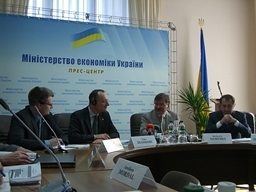
EFTA and Ukraine commence free trade negotiations

Negotiations on a broad-based Free Trade Agreement between the four EFTA States (Iceland, Liechtenstein, Norway and Switzerland) and Ukraine were launched in Kyiv on 21 April 2009.
During the opening ceremony, Ukrainian Vice Prime Minister Hryhoriy Nemyria and Minister of Economy Bogdan Danylyshyn underlined the significance of launching free trade negotiations in the midst of the current world financial crisis and of the strong political will to avoid protectionist measures. They highlighted the role of a strong and reliable partnership with the EFTA countries and expressed the hope that the elimination of trade barriers will benefit their citizens and increase welfare.
EFTA Deputy Secretary-General Didier Chambovey welcomed the launch of negotiations with Ukraine, which is an important trading partner of the EFTA States. He stressed the importance of creating new market opportunities in a period of global economic downturn and highlighted EFTA’s ambition to swiftly conclude a comprehensive free trade agreement building on WTO rules and commitments.
The first round of negotiations with high level representatives from both sides is being held until 22 April. Mr Einar Gunnarsson, Director and Chief Negotiator from the Icelandic Ministry for Foreign Affairs, is acting as the spokesperson for the EFTA States, while the Ukrainian delegation is led by Mr Valeriy Pyatnitskiy, Deputy Minister of Economy.
Building on preparatory work, the first round of discussions is focusing on establishing a joint document which details the general framework for the negotiations as well as the scope and principles of the future Free Trade Agreement between the partners.
Economic relations between the EFTA States and Ukraine
With a land area of about 600’000 sq km, Ukraine is Europe’s second largest country. Its main export items to the world in 2007 were iron and steel and related products, together with machinery. The main import items in 2007 were mineral fuel, vehicles, machinery, and electrical machinery.
The value of total EFTA-Ukraine merchandise trade (imports plus exports) in 2007 amounted to nearly 900 million USD, up 23% from 2006[1]. In 2007, the EFTA States exported goods to Ukraine worth over 690 million USD, a rise of 30% from 2006 in nominal terms, and imported goods from Ukraine worth US$ 200 million, an increase of 4% from 2006. Taking a slightly longer-term perspective, bilateral trade has grown strongly since 2000, with annual growth rates fluctuating between 12% and 68%.
Data for trade in services between Ukraine and the EFTA Member States is not available on a bilateral level. In terms of foreign direct investment, according to data published by the Swiss National Bank, FDI flows from Switzerland to Ukraine reached 550 million USD in 2006, bringing Switzerland’s stock of FDI in Ukraine close to one billion USD. According to Norwegian statistical sources, Norwegian FDI stocks in Ukraine amounted to 724 million USD in the same year. Corresponding figures regarding Iceland are not available.
In the context of its accession to the WTO in 2008, Ukraine has undertaken – and continues to undertake – important steps to revise its legislation and institutions to comply with international standards. Due to these processes, the common ground between EFTA and Ukraine for negotiations on a Free Trade Agreement has expanded substantially in the recent past, and will further increase in the near future.
Elements of an EFTA-Ukraine Free Trade Agreement
It is foreseen that the EFTA-Ukraine Free Trade Agreement will have a broad coverage and entail areas such as trade in goods, rules of origin, trade facilitation, sanitary and phytosanitary measures as well as technical barriers to trade, trade in services, investment, competition, government procurement and intellectual property rights. Institutional and dispute settlement provisions will complement the Agreement. The Parties aim at a swift negotiating process and at concluding it by mid-2010.
EFTA as a free trade partner
EFTA has established one of the most extensive networks of Free Trade Agreements worldwide. In addition to the EU as the EFTA States’ most important economic partner, EFTA’s free trade network currently extends to 21 countries and territories around the world – covered by 17 Free Trade Agreements – and is being developed further.
[1] Bilateral trade statistics between the EFTA Member States and Ukraine are taken from the Global Trade Information Services database (EFTA Member States as the reporting countries).